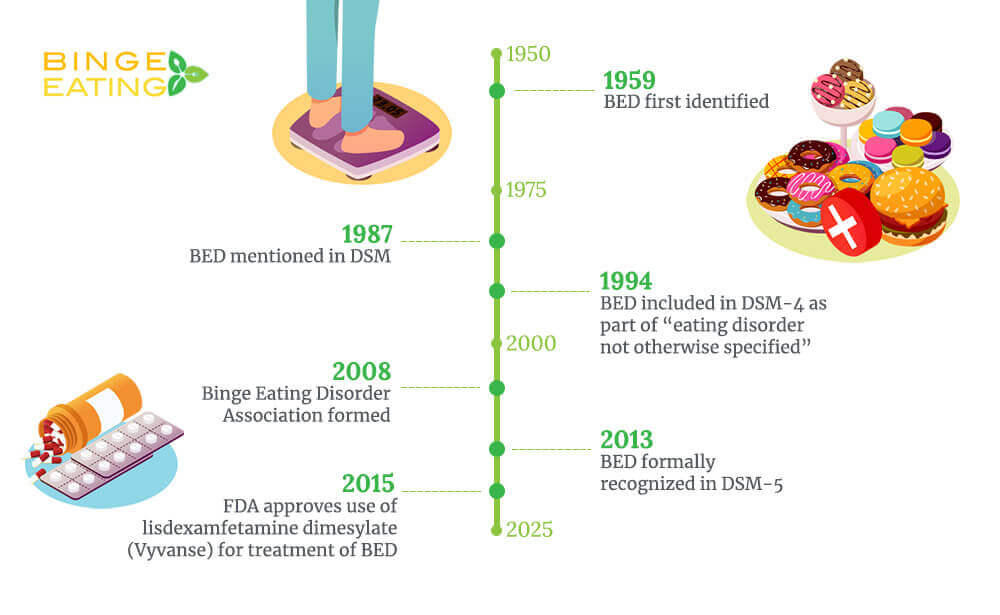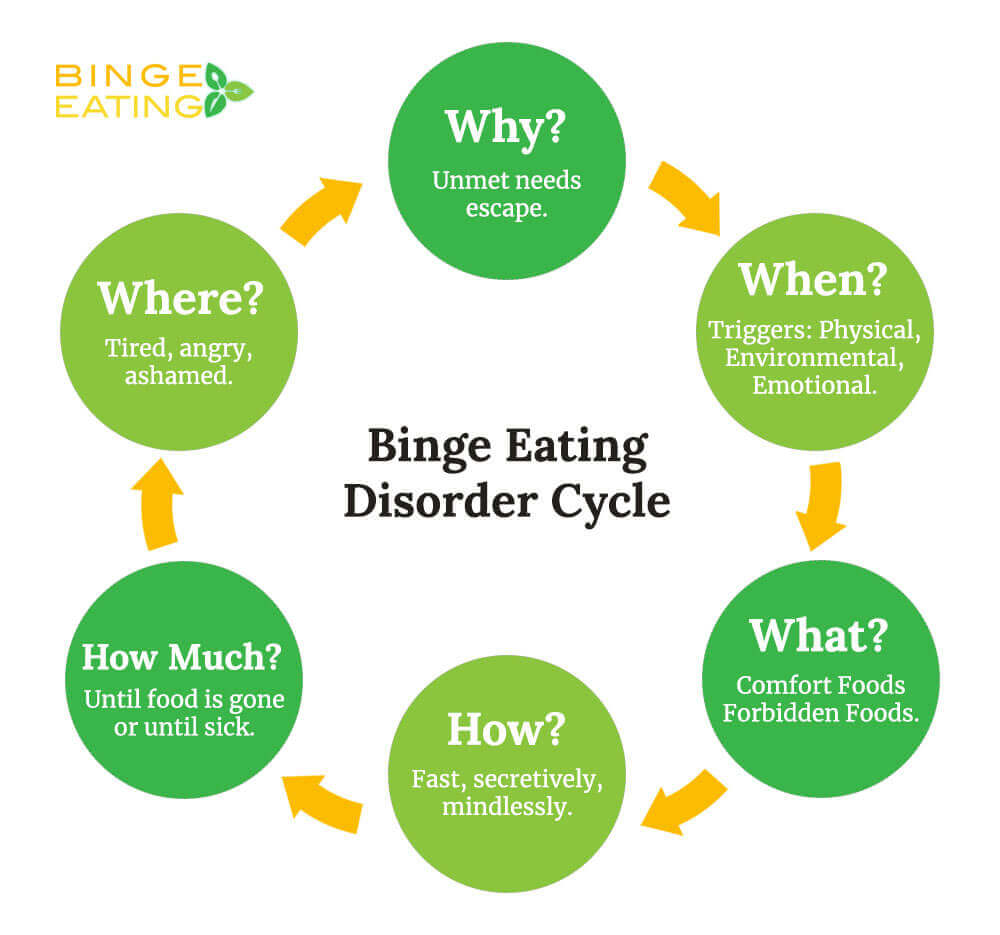In this guide we cover everything you need to know about Binge Eating Disorder (BED).
Here is what you’ll learn:
• Binge Eating Disorder 101: How it Feeds Off of You
• Main Causes & Symptoms
• How to Support Someone You Care About
• Treatment Options & Much More

What is Binge Eating Disorder?
Binge Eating is a term applied to an eating behavior when large amounts of food are consumed in a limited period of time (up to two hours). This eating behavior is often accompanied by a feeling of lack of control over what or how much food is eaten, and being disconnected from hunger cues and nutritional needs..
Binge Eating is a disorder associated with the feeling of compulsion and real loss of control. “In spite of my best plan, I ate so much all over again,” is a common refrain from a person who suffers with binge eating. Those with Binge Eating Disorder (BED), will often eat more, even after a binge. Often what follows are feelings of brutal self defeat and suffering.
The recurrence of these binge episodes is characterized clinically by the frequency of at least once a week for a continuous period of at least three months. Overeating moves into this diagnosable condition, when it fits certain characteristics that are so common in the American culture around food, feeding, dieting and nutrition.
In a diet-obsessed culture where 91% of americans are overweight or obese the constant fight to eat better, “eat right”, and be healthier as it relates to food seems endless. In the past four decades, the way the nation feeds has changed radically, even how we eat as families has shifted in fundamental ways. At the heart of the binging struggle is the loss of control with food, and unintended binges that result in remorse and feelings of failure.
Binge Eating Disorder was first described in 1959 by Dr. Albert Stunkard and is considered the most common of all eating disorders (see timeline).
Risk Groups
Anyone can develop Binge Eating Disorder regardless of gender, age, weight or social status, and although it appears to be more common in women, men no doubt develop life-altering struggles with binge eating behaviors.
Many who suffer with binging also suffer with how they feel about themselves (it is estimated that 78.9% of people with Binge Eating Disorder have some type of psychiatric diagnosis, including depression, low self-esteem or anxiety) as well as an overarching concern with weight and physical appearance. This disorder is often accompanied by feelings of anguish, shame and guilt.
Estimates illustrate that more than a ⅓ of those undergoing bariatric surgery (stomach reduction) have Binge Eating Disorder (verywell mind).
Like other eating disorders, Binge Eating often begins in childhood or adolescence due to family influence, and can also be due to hereditary, environmental and sociocultural factors.
What Is It Like to Be a Binge Eater?
There are many feelings, behaviors, and triggers involved with binge eating. As with any disordered behavior, the circumstances are complex.
Feelings: When eating, there may be an initial feeling of pleasure, being able to enjoy the taste and texture of food, and eating at a slower pace. However, unpleasant feelings and lack of control can quickly emerge, and feelings of anguish, shame or guilt rise up. The more food consumed, in one sitting can trigger feelings of disgust, shame and guilt, which intensifies as the binging continues.
Ingestion Speed: At a fast pace and in a short time, large amounts of food are mechanically ingested during a binge. According to the results of a study by a group of researchers from Columbia University, women suffering from BED consume food twice as fast as women without an eating disorder.
Agitation: It is common that agitation is present before and during an episode of binge eating. With desperation an intense desire for food is felt that inevitably incites a feeding. If the cupboards are bare, a trip to the store will ensure the feelings of agitation and desperation are consoled and quieted. .
Secrecy: The intense shame that typically accompanies these behaviors, leads to secrecy, keeping away from the eyes and criticism of others, happening in solitude, or under secret strategies such as taking food to safe places to not be discovered.If no one else can see the food or the behavior, then there is a sense of control that eases the guilt and shame.
Altered Sensation of Being: Many times the report of an involuntary and mechanical behavior that takes over, as if it were not conscious. An “autopilot” state that shuts down any awareness of the behavior. It is often reported that this happens when the episode of feeding is paired with distractions such as watching TV or listening to loud music, providing an emotional distancing from the physical actions.
Loss of Control: For some, the loss of control is always present, while for others it can creep up during grocery shopping, preparing dinner, or somewhere during a meal. Regardless of the fluctuation and timing, the feeling of being out of control, of not being able to moderate, of feeling like there is no other choice, is an integral part of BED behavior.
Diagnosing Binge Eating Disorder
For a correct diagnosis of BED, the American Psychiatric Association has established a set of diagnostic criteria that include:
• Eating faster than normal.
• Eating until you feel uncomfortably full.
• Eating large amounts of food, even when you are not hungry.
• Eating a large amount of food alone out of shame.
• Feelings of depression, disgust or guilt at the excesses consumed.
A diagnosis includes at least three of these symptoms, occurring twice a week, for 6 months without compensatory behaviors such as purging, laxatives or other means of compensation.
What Are the Causes?
The causes of this disorder are linked to biological, psychological, genetic and behavioral factors. However, it is possible that there is a strong relationship between this anxiety, depression disorders, fear and stress.
A binge eater understands the emotional difficulties of feeling hungry or eating to forget a problem, to change the focus of a thought. Food is a defense being used as a solution to uncomfortable feelings, to avoid loneliness, failure or abandonment.
This disorder is also related to self-esteem. Even high-performance athletes or celebrities develop the disorder due to the great exposure they suffer and the need to always be beautiful, perfect, or to always win.
There are many causes, and many triggers to binge eating episodes. There are almost 3 million people in America who struggle with binge eating disorder. The root of which is complex and different for everyone. There is no perfect formula for the disorder, and so the list of causes is not concrete.
What Are the Symptoms?
The main characteristic of periodic binge eating disorder is eating an excessive amount of food while feeling out of control of the behavior. Binges usually happen quickly, in a period of up to two hours, and frequently, meaning more than just once in a while. The behavior is followed by feelings of guilt, shame, and remorse.
Other frequent symptoms are:
• the feeling of lack of control, during or right after overeating.
• not wanting l to vomit or get rid of the food post-consumption.
• eating at an accelerated rate.
• an uncontrolled desire to eat, even without hunger.
• choosing to eat alone or hiding meals, so as not to be embarrassed.
• feeling depressed, ashamed or guilty.
How Treatment Works
BED treatment is multidisciplinary, so it can be carried out jointly by psychologists, nutritionists and professionals counselors. However, because it is qualified as a mental disorder, psychological intervention is essential.
If you suspect that you or someone you love is suffering from this disorder, we encourage you to call a professional today. A thorough assessment and evaluation is critical in identifying behaviors, coping mechanisms, and underlying factors that trigger the behavior.
There are a variety of treatment options that can be combined according to the specific needs of each person. Treatment options include psychotherapy, regular participation in peer-to-peer support groups (group or family therapy), nutritional planning and counseling and, in some cases, medication.
The first step is to find a specialized therapist to help identify and understand why someone is eating compulsively and how to address the underlying motivations of the behavior. In this assessment period, in addition to examining physical condition, parameters such as eating habits, emotional health, perception of body image and feelings about food will also be evaluated.
There are many types of therapeutic approaches to BED. Once is Cognitive Behavior Therapy (CBT). CBT aims to change negative thinking patterns that can trigger episodes of binge eating and can be effective in maintaining a reduction in the frequency of behavior.
In several studies with CBT, improvements have been found in self-esteem, interpersonal struggles, mood and quality of life , in addition to an increase in the feeling of well-being.
Nutritional counseling, associated with private and group therapy, combined with physical exercise and structured healthy food plans can be the most effective methods of treatment.
There are many different kinds of treatment options including in-patient, out-patient, day, night, or weekend programs, group therapy, individual therapy and peer-to-peer support groups. Depending on the diagnosis, a treatment professional will assign the appropriate treatment protocol.
Prevention
To prevent BED, it is necessary to be able to see and identify the primary symptoms and behaviors. It is necessary to monitor feelings of guilt, shame, excessive impulsiveness in the presence of food or suffering from low self-esteem, when it results in disordered eating behaviors.
Once the symptoms, behaviors and emotions are identified, it is important to seek professional help. Exploring treatment options that suit a person’s lifestyle, financial and insurance means, and diagnosis are important steps to take.
How the Family Can Help with Treatment
A family with a loved one facing an eating disorder can often fall into dysregulation in old patterns of lack of communication, painful silences, accusations, blame, shame, feelings of guilt and frequent unfulfilled promises of change. However, families need to understand that they are not “guilty” of the disease, nor should they blame their loved one for the behavior.
In family therapy and in peer-to-peer support group meetings, family wounds heal in parallel with those of their loved one seeking treatment for the eating disorder.
We believe that family communication is integral to the entire family recovering. However, most families “communicate” inappropriately.
The involvement and recovery of the family itself is fundamental when faced with an eating disorder or any addictive disease. The family itself faces its own fragility together, as individual players on the team. When a child is affected by an eating disorder, the very structure of the family is shaken.
Many parents cannot bear the pain and default to accusing each other. Siblings may feel unprotected by their parents, who focus their attention on the loved one struggling.
However, if the family begins to understand that their loved one is not the disease itself, then it is possible to push guilt aside, take responsibility and participate in treatment. Then the whole family is strengthened and transformed, resulting in an improvement in relationships, boundaries, codependencies and respect for the individuality of each member.
What We Need to Know
- Admit that there is a serious problem at home. Denial of the disease is often an integral part of the picture.
- Begin to get help for the entire family, most importantly your loved one.
- Your loved one may be suspicious of doctors and therapists and see them as enemies. Be prepared to guide with love.
- Know that the mortality rate and physical complications are high, so this is serious.
- Sometimes initial improvements do not represent concrete advances. Time takes time, so keep on keeping on.
- The need to control symptoms, triggers, new behaviors, nutrition and more are daily battles.
- Relapse and social isolation are very common.
- Make it clear that the family cares. Demonstrate that the concern is related to your loved one’s physical and emotional health. Make it clear that this is about saving his/her life, whether s/he wants to right now or not.
- Peer-to-peer groups offer a framework of security for parents, siblings, and spouses, since they provide the development of feelings of self-esteem, affection and hope.
For more information on Binge Eating Disorder recovery programs, please reach out to Breathe Life Healing Centers for a free assessment at (800) 929-5904.
If you or someone you love is struggling with binge eating disorder and would like to talk to someone, call the National Eating Disorder Association hotline at 1-800-931-2237.





